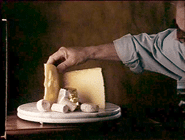The convergence of Jean-Marie Straub and Danièle Huillet’s A Trip to the Louvre and experimental filmmaker Mark LaPore’s transfixing ethnography Kolkata at this year’s View from the Avant-Garde provided the proper frame of mind to revisit Harun Farocki’s meditation on the art of consumerism, Still Life, a film that on the surface seemed to be a corollary to his interior monologue, self-confessional in Between Two Wars: part conceptual apologia on the necessity for artistic compromise (Farocki had accepted commission work for print advertisement in order to finance the film), and part de-exoticism of the creative process and ritual of aesthetic (re)presentation that underlies all commercial production. From one perspective is Kolkata in which LaPore’s stationary camera takes on the characteristics of pre-Renaissance art, creating a composition in which the subject remains fixed while the peripheral frame becomes the dynamic element (an aesthetic similarly employed by Amos Gitai) as objects transect, ornament, or otherwise distract from the foreground, creating complex, seemingly oxymoronic juxtapositions of youth and aging, poverty and opulence, decay and vitality that reflect the state of perpetual transformation in modern-day Calcutta. Similarly, the opening image of the precursor still life painting in Farocki’s film contains its own richly textured, baroque, self-encapsulated constructed world where humans and inanimate objects compete on equal footing (or rather, canvas space) for the viewer’s attention – each composition revealing an inherent duality (or even multiplicity) of meaning.
From a corollary perspective, the process of engaging the viewer towards decoding meaning by challenging conventional perspective and “ways of seeing” defines the nature of image presentation in A Trip to the Louvre where layers of sub-frames present a logical progression that spirals outward toward the resolution of overarching image. In Still Life, Farocki proposes that contemporary society has become attuned, not to see this structural complexity of image presentation, but rather, to the coding of associative images that converge towards a consumerist ideal. Therefore, in this context, a painting of an open market booth that juxtaposes a vendor selling assorted fruits vegetables in the foreground as two lovers steal a kiss in the background does not serve to convey a richness of ancillary, quotidian detail and sense of realism to the constructed image, but rather, to present a consumer-programmed associative link between inanimate objects and human beings where the consumption of goods (the marketed produce) provides a gateway to pleasure (the lovers’ rendezvous). It is this ritualized pursuit of the precise moment of balance between visual composition and image-embedded coding that defines the heart of Farocki’s exposition – a visual state in which the synthetic production of images the delineation between art and commercialization is blurred – an aesthetic point of convergence towards a singularity of manufactured illusion.
© Acquarello 2005. All rights reserved.
